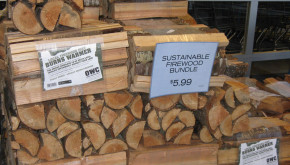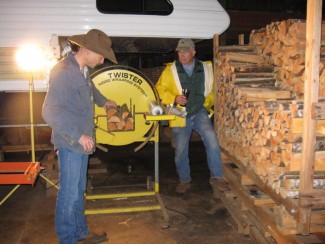
Regardless of where you are located or the size of your property you can probably find some non-timber forest products (NTFPs). These could range from morels you harvest for your own dinner, truffles you sell to a restaurant, or ginseng you cultivate for a commercial market. What you have on your property, and its potential value varies greatly. What doesn’t, is that most NTFP marketing opportunities are very specific and can be hard to get into. Harvesting and adding sufficient value to your products can be labor intensive, perhaps not even profitable on an individual scale. Which makes the Oregon Woodland Coop (OWC) model so inspiring. When you work together to add value to and market your products, you increase your efficiency, selling power, and supply of products.
In the last several years, OWC has been working to explore opportunities with non-timber forest products. They have procured grants to do marketing research, investigating the chemical properties of local plants, and have worked hard to educate their members about how to optimize their land and time. Below is a sampling of NTFP projects.
About the Oregon Woodland Coop
“The Oregon Woodland Management and Sales Cooperative (OWC) is a group of woodland owners formally organized into a cooperative complying with the State of Oregon statutes governing cooperatives (ORS, Chapter 62). It is a group of people working together to improve each member woodland owner’s ability to manage their woodland and market their woodland products over the long term through members helping members. Members take advantage of educational opportunities, networking opportunities and the services of the Cooperative’s contracted professionals to improve their ability to manage their woodlands and market their woodland products in a manner they could not do alone. The Oregon Woodland Cooperative (OWC) is led by a Board of Directors composed of an elected President, Vice President, Secretary/Treasurer and, currently, four Directors. The Board oversees the business of the Cooperative. It welcomes input from the membership regarding current activities, policy and potential new services. A meeting of all membership is held annually.”
Find out more about the OWC here: http://www.orwoodlandco-op.com/
Firewood
OWC has purchased a firewood splitter and bundler and is collectively splitting and bundling firewood to sell to grocery stores and other venues around Portland. Eight members of OWC are contributing to the firewood market to date, and there is demand for more to get involved. Firewood sales are primarily during the winter, and OWC is now tapping into the summer market (likely for camping use and special home events where a wood fire adds atmosphere). 7953 bundles of firewood and 1274 bundles of kindling have been sold since October 2010 for a return of $35,524 in sales. The total sales amount to 53 cords of roundwood. The addition of kindling to the firewood offerings this year has been well received in the market. 3.5 cords of bulk firewood have also been sold for a return of $800.
Essential Oils
OWC is continuing to test the suitability of different species of trees and shrubs for making essential oil products such as lotions, air fresheners, and soaps. They are also test marketing these products at events such as farmers markets. They anticipate placing these products in retail stores as well, particularly stores that have “aroma” departments or specialize primarily in aromatherapy products. The primary sales goal, however, will be the internet market, sometimes called “e-tailing”.
Special Milling/ Crafts
The Co-op’s partner, North Woods Figured Woods (owned by members Susan and Les), has been busy producing and marketing figured wood products across the country. Woods in Oregon suitable for turning include maple, madrone, and other hardwoods. With Co-op help, a national survey was conducted with over 300 wood turner organizations, resulting in over 150 responses. Sample products (turning blanks) were provided to 80 respondents, which is beginning to generate orders for turning blanks. Les “took the show on the road”, with an exhibit at the National Wood Turners Association in Minnesota. Les reported a lot of interest in their product.
Lessons learned so far: 1) Not all maple, madrone or other wood has equal value for turning, and 2) The value of finished turning products can be very high, since “beauty is in the eye of the beholder”. However, there is a chain of labor-intensive operations that must be performed before a given piece of “raw” figured wood becomes marketable. Those providing wood can get very good prices for their figured wood, but the standard for price comparison should be the alternative value of the wood, which may be only pulp or sawlog.
Floral greenery
OWC sells fresh conifer boughs in November and December from Noble fir, Western white pine, Western redcedar, Incense cedar, Port Orford cedar, Arborvitae, Ponderosa pine and possibly other species. OWC has worked to train members in identifying commercial species and making floral arrangements with the help of a local Florist owner/operator.
Edible Foods
Oregon is home to an “Oregon White Truffle” a delicious and valuable product, if you have it on your property. A test run last spring with a truffle dog on 4 members’ properties yielded mixed results, primarily due to the lateness of the test at lower altitudes. However, some truffles were found along with “truffle remains” – the decaying remains of truffles. The spring hunt was a good learning experience, and another truffle dog hunt this fall is being planned for the prime truffle season. Eric Jones, Coop member and leader of the Institute for Culture and Ecology, is assisting with this project.
Medicinal Plants
OWC is testing Oregon Grape for berberine content, a commercial medicinal extract. Samples sent to a laboratory in North Carolina indicate that the low variety of Oregon grape, Mahonia nervosa, produces significant amounts of berberine (current markets much prefer the tall variety, Mahonia aquifolium). As expected, the roots contain the highest concentration, but the stems also show significant amounts. The fall test will indicate if fall collection is significantly better than spring collection.
Ecotourism
Inviting the public onto your woodland has the double benefit of exposing people to the out-of-doors and educating them about family forest management. OWC has been doing some market research with Portland area high-end grocery stores, and results point to a solid interest in attending a “Walk in the Woods” on a tree farm. The next step will be to host a tour of up to 25 people spending from 3 hours to most of a day touring one or two woodlands.
Finding or Starting your Own Coop
Since not all our readers live in Oregon, I encourage you to look for an NTFP cooperative in your area or start one yourself. There are many types of cooperatives so organizations that support urban farms, credit unions, or other coops may have resources and expertise to help you with a small woodland cooperative as well. Try one of these links for starters:
Northwest Cooperative Development Center: http://www.nwcdc.coop/index.htm
Ohio Cooperative Development Center: http://ocdc.osu.edu/
Did you know 2012 is the International Year of Cooperatives? http://usa2012.coop/


